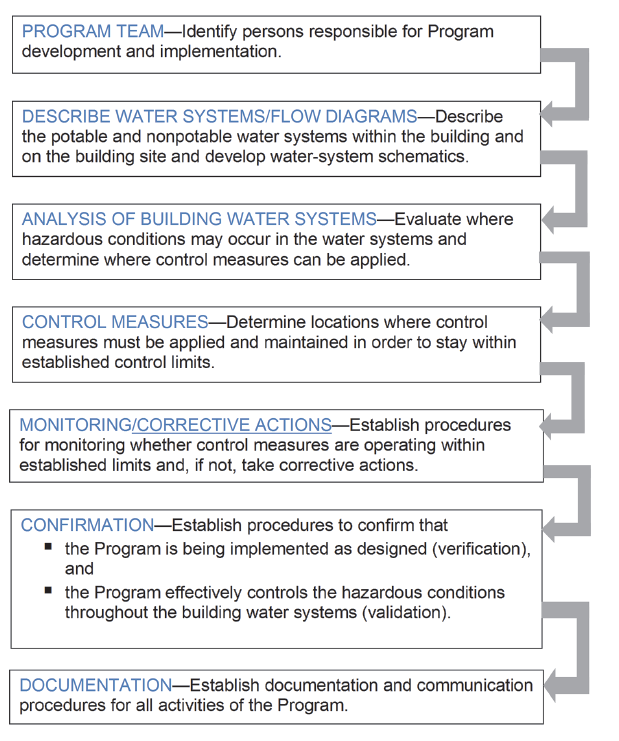INDUSTRIAL/ COMMERCIAL
![652039102_2616d8f26d_o[1] 652039102_2616d8f26d_o[1]-resize519x839](/corp/resources/Images/652039102_2616d8f26d_o-resize519x839.jpg?language_id=1)
Commercial/Industrial buildings have large more complex plumbing, heating and cooling systems with great opportunity for transmitting Legionella. In 2015, the American Society of Heating, Refrigerating and Air-Conditioning Engineers (ASHRAE) created a standard for risk management in large building water systems (ANSI/ASHRAE Standard 188-2015) to manage potential risks. This standard includes a Water Management Plan and general requirements for building operator and businesses. To reduce liability, many insurance companies also require businesses to maintain Water Management Plans. ANSI/ASHRAE Standard 188-2015 building water safety plan consists of seven elements.

After the team is assembled, the building is surveyed to determine whether it has one or more of the following elements:
- Open- and closed-circuit cooling towers or evaporative condensers that provide cooling and/or refrigeration
- Whirlpools or spas, either in the building or on the site; or ornamental fountains, misters, atomizers, air washes, humidifiers, or other non-potable water systems or devices that release water aerosols in the building or on the site.
- Multiple housing units with one or more centralized potable water-heater systems.
- The building is more than 10 stories high (including any levels that are below grade).
The ANSI/ASHRAE standard for legionella also pertains to hospitals, healthcare facilities and nursing homes. Details for these systems is found on the Hospitals/Healthcare Facility page. Even if buildings do not contain any of the above elements, it is still a good idea to create and implement a water management plan.
ASHRAE has also developed a guideline, Managing the Risk of Legionellosis Associated with Building Water Systems to help building operators with information and guidance for control of legionellosis associated with building water systems. The guidance is useful to operators of hotels, office buildings, hospitals and other health care facilities, assisted living facilities, schools, universities, commercial buildings, industrial buildings, and centralized systems in multifamily residential buildings.
The Center for Disease Control, CDC, has created a toolkit for large buildings to help make sure of the safety of staff and the public. The CDC toolkit can help identify areas of concern where Legionella might grow and be transmitted. The toolkit includes practical resources to help make sure a comprehensive and effective system that holds to industry standards.
Water management plans should be continuously maintained and updated. A new management plan should be developed when more than 2 years or following any changes in these scenarios:
- The last risk assessment
- The building use has changed
- New information exists about risks or control measures
- Checks indicate that control measures are no longer effective
- If a case of Legionnaires' disease is associated with the system
This information is provided for the sole purpose of providing our customers with currently available information regarding actions to minimize exposure to Legionella. The information provided on this site is based on publicly-available data and American Water does not guarantee the accuracy of this information on this site or of the information provided on the third party sites linked within. This information, or reference to any devices or services is not intended for any commercial, legal or other use. The materials and information contained in this site are provided “as is” and without warranty of any kind.
